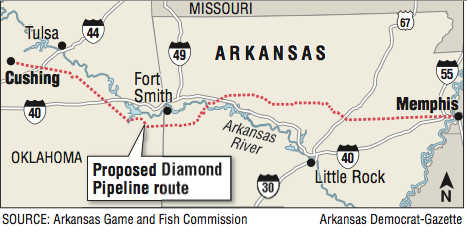Diamond Pipeline LLC has received approval from the Arkansas Public Service Commission to build its crude-oil pipeline across five waterways in the state, including the Arkansas and Mississippi rivers.
RELATED ARTICLE
http://www.arkansas…">Two pipeline operators to merge
The decision comes after Diamond Pipeline struck a multimillion-dollar deal last month with Clarksville Light and Water Co., putting an end to the municipal utility's opposition to the proposed pipeline route.
The commission's approval order, issued by Administrative Law Judge Susan D'Auteuil, was filed Aug. 31. Construction of the pipeline is to start this year and finish in 2017.
Diamond Pipeline, a joint venture between Plains All American Pipeline and Valero Energy Corp., is planning to build a 440-mile pipeline that will move oil from Cushing, Okla., to Valero's refinery in Memphis.
The $900 million pipeline will run across north-central Arkansas and have a capacity of 200,000 barrels per day. The 20-inch pipeline will ship sweet crude from shale formations in Texas and North Dakota.
The U.S. Army Corps of Engineers examined water crossings on the pipeline's path, and the agency's Little Rock district approved permits for 443 crossings. The Public Service Commission had the task of examining five of those waterways.
The proposed route generated concern among some, including Clarksville Light and Water and the Arkansas Health Department, about the possibility that it could place drinking-water sources in Arkansas at risk.
Clarksville Light and Water provides drinking water to about 28,000 people in Clarksville and surrounding areas.
Spadra Creek, which the pipeline will cross, feeds into Lake Ludwig, a backup water source for the utility. The pipeline also will cross Big Piney and Little Piney creeks, which flow into Piney Bay, Clarksville Light and Water's main water source.
Clarksville Light and Water reached a deal with Diamond Pipeline that will require the company to take steps to protect the drinking-water sources.
Under the agreement, Diamond Pipeline will provide $6.6 million to pay for an extension of a pipe that feeds a water-intake facility on Spadra Creek in Johnson County, locating it north of the pipeline's proposed path.
If that pipe extension is not approved by regulatory agencies, the funds will be increased to $8 million to construct a new water-treatment facility on Spadra Creek.
If built, the water-treatment facility will be placed north of the pipeline's path so, if there is an oil spill, the crude will move south with the flow of water, and away from the treatment plant.
Diamond Pipeline also will be required to have other safety measures in place, such as a boom -- a floating barrier used to contain oil spills -- on-site at the Piney Bay Intake Facility that can be used if there's a leak.
As part of its agreement with Diamond Pipeline, Clarksville Light and Water withdrew its petition to intervene in the pipeline's permit hearing with the Public Service Commission.
The commission held its hearing on Aug. 18 to review the effect of the pipeline's route on the five Arkansas waterways the pipeline will cross. Other than the Arkansas and Mississippi rivers, the commission looked at the possible implications for the White River, the St. Francis River and the Illinois Bayou.
Because Clarksville Light and Water withdrew its petition, no one spoke against the pipeline project during the commission hearing.
In her approval of the permit, D'Auteuil noted, "no evidence was presented that the navigable water crossings will cause unlawful interference with any other paramount public or private use of the waterways or their underlying beds at the point of crossing."
Plains All American came under scrutiny when one of its pipelines burst in 2015, sending thousands of gallons of crude into the Pacific Ocean.
Two large energy pipelines that run through Arkansas have ruptured in recent years.
In 2013, an oil pipeline belonging to Exxon Mobil ruptured between two houses, sending tens of thousands of gallons of crude into a neighborhood in Mayflower and a cove of Lake Conway.
In 2015, Spectra Energy's natural-gas pipeline burst in the Arkansas River, releasing 3.9 million cubic feet of natural gas in the Arkansas River. The pipeline rupture created two geysers in the river near the Clinton Presidential Center in Little Rock. Chunks of concrete, possibly from the pipeline, also damaged a tugboat nearby.
Diamond Pipeline has repeatedly emphasized the reliability and safety of its pipeline. The company said it will use horizontal drilling to place the pipe underneath water crossings.
Horizontal drilling is done by angling the pipeline gradually beneath the river and pushing it across. By doing this, the ends of the pipeline are away from the riverbank and at least 35 feet below the deepest part of the river or creek, Brad Leone, a spokesman for Plains All American, said in an email.
"Inline inspection tools are run post-construction and at regular intervals thereafter to confirm the integrity of the crossing and installation," he said. "If any significant defects are noted, the crossing will be shut down and replaced."
Horizontal drilling is the safest way to place a pipeline under a water crossing, said Eric Wright, a special pipeline representative with the International Union of Operating Engineers.
"They can go underneath the river over a mile long and have no issues," he said. "You have to put [the pipe] deep enough to where nothing can get to it."
A Section on 09/07/2016
